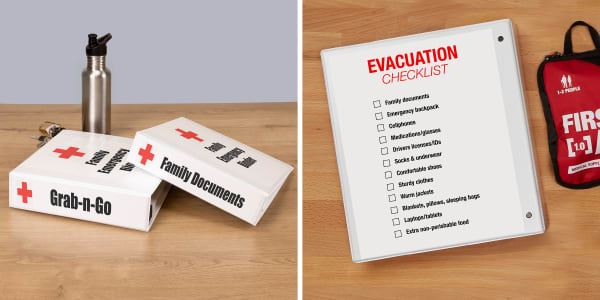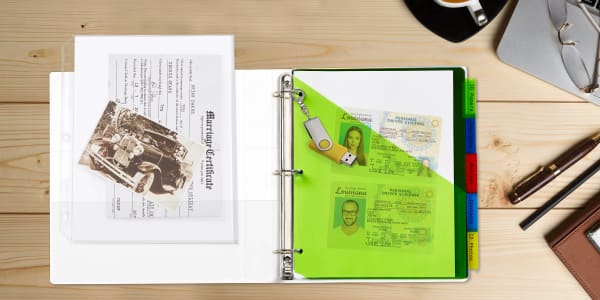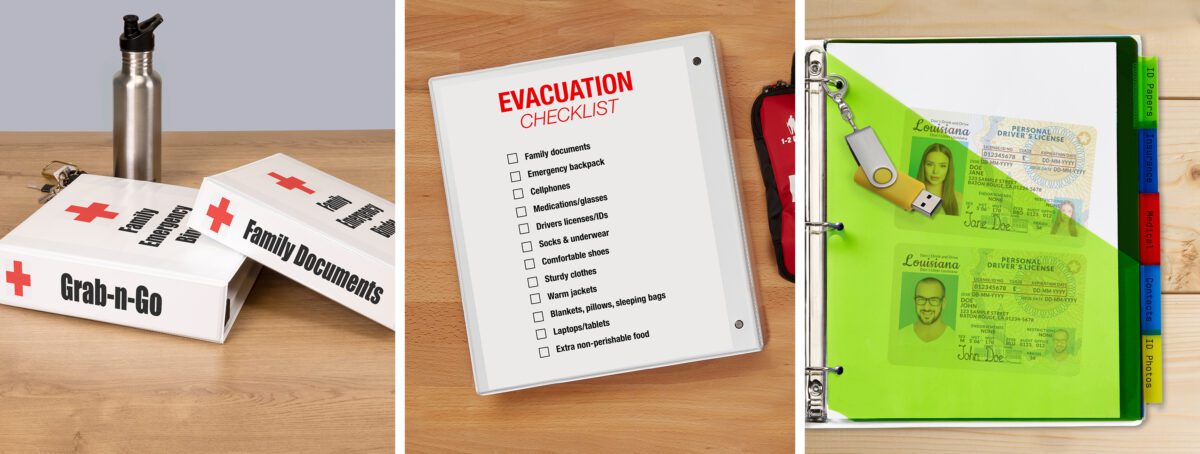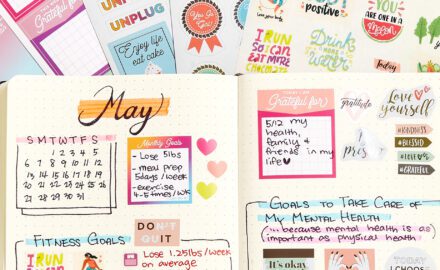How to put together a family emergency binder, what to include, and more
During an emergency, you and your family may need to exit your home quickly, even immediately. A family emergency binder should be part of your disaster preparedness plan because it’s the best way to keep all of your important documents together and easy to transport.
Family emergency binders are especially helpful in cases where you may not be able to return to your home right away. For example, disasters such as fires, floods, earthquakes, or hurricanes.
Grabbing your purse or wallet is simply not enough. You may need certain documents to get medical attention, cross borders, access funds, and recover after the disaster. That’s why we’ve compiled these 8 emergency binder tips to help you keep your family safe.
Other articles you might like:
- 5 Allergy Safety Tips to Help You Avoid Food Mix-Ups
- Back to School: Kids Labels You Can Actually Clean
- 5 Mom-Approved Organization Ideas for Kids

1) Gather key documents needed in an emergency
To begin with, you’ll need to figure out the documents you need for your family emergency binder. Start with identification papers. This includes passports, birth certificates, social security cards, and driver licenses.
Then move on to medical information for each family member. This includes health insurance cards, immunization records, medical conditions, list of current prescribed medications, and any known allergies.
Next, you’ll need insurance papers in case of property damage. This includes contact information for your insurance company and bank, as well as copies of your insurance policy and other documents related to property ownership (such as the deed to your house).
After that, make a list of emergency contact numbers including family and close friends and print recent ID-style photos of each family member. If your phone is left behind, damaged, or the battery dies, you’ll need the numbers as well as access to photos to share with emergency responders.
Finally, create an evacuation checklist. Physically getting out of a dangerous situation is always step number one. If you have longer to evacuate your home, having a checklist can help you stay focused and get out with everything you need.
2) Use copies for a “grab-n-go” emergency binder
It’s a good idea to have at least one “grab-n-go” family emergency binder. That is to say a binder that is super easy for any family member to access quickly. You might even want to make several to store near exits and in family vehicles.
While it’s important for safety purposes that you have a “grab-n-go” family emergency binder, it’s not necessarily a good idea to keep original documents out in the open. Especially sensitive documents like social security cards which you should keep somewhere secure.
Instead, make copies of all the documents you’ve gathered. Use the copies to create as many “grab-n-go” emergency binders as you need.
3) Keep original documents somewhere secure
It should be noted that while you should keep original documents secure, they still need to be easy to locate and transport in case of emergency. A family emergency binder containing original documents is a great way to keep important documents together. If you’re still deciding on what type of binder to use, our binder resource page is a great place to quickly browse all styles and compare features.
Once you’ve collected your original family documents, organize them in a binder so that it’s easy to store them anywhere. Keeping important family documents in a binder also keeps them from contributing to paper clutter when you’re organizing paperwork in your home office.
4) Organize your family emergency binders for quick access
Now that you’ve got all your important documents gathered and copied, it’s important to organize your family emergency binders. The main thing to consider is how to make the information easy to find quickly.
This is important because you may not be able to think beyond immediate survival during a crisis. In fact, your brain is wired to behave differently in an emergency. You may become hyper-focused on one thing or lose all focus as your brain floods your body with adrenaline and cortisol hormones.
One thing you can do to help everyone keep a cool head is make some information visible on the outside of your family emergency binder. For example, display your evacuation checklist on the outside of a view binder.
Another thing you can do is separate the different types of documents so that the binder is easy to navigate. Create sections in your family emergency binders for ID papers, medical info, insurance papers, emergency contacts, and ID photos.
Make sure you clearly label the spines of your family emergency binders to indicate which are “grab-n-go” copies vs. original documents.

5) Update ID photos every year, especially for kids
If you find yourself in a situation where family members are missing after a disaster or emergency, photos are much better tools than descriptions alone. For that reason, it’s important to make sure you have recent portrait-style photos of each family member.
While the adults in your household may not need a new picture each year, the kids definitely do. Kids grow so quickly that updating every year really is necessary. Luckily, school pictures are perfect for including in your family emergency binder.
7) Back up important files, passwords, and login information
In the digital age, much of the important household tasks we handle are now online. That information can definitely come in handy during an emergency. Not to mention the headaches it will save to have important websites, passwords and login information available for family members if you aren’t able to share them.
To do that, consolidate all the digital information you need onto a flash drive and clip it into your family emergency binder. You’ll be glad you have it on hand if your electronics get left behind and you no longer have access to saved passwords or bookmarked sites.
8) Set a schedule to update your family emergency binder
In general, updating your family emergency binder once a year is a good rhythm to strive for. Yearly updates ensure all documents and information are relevant and useful. Additionally, ready.gov recommends updating emergency supply kits once a year so you may as well update everything at the same time.
Try to pick a date or time of year that is easy to remember. For example, right after you file taxes since you’re likely to have reviewed much of your household paperwork. Or, after school pictures when you will have fresh new photos of your kids.
Whatever date or time of year you choose, make sure it’s something that is easy to remember and makes sense for you and your family.
Emergency binders are tools to help keep your family safe
In summary, creating a family emergency binder is a vital part of preparing for disasters. In fact, you should at least have two: one for original documents and one that contains copies and can be grabbed quickly.
Create copies of your family documents for “grab-n-go” binders that you can store near exits and in vehicles. Clearly label “grab-n-go” binders vs. the binder for your original documents. Organize the documents in all your binders and update information and photos once a year.
An organized binder that’s easy to transport makes it easier for you and your family to find critical information when you need it. Does your family disaster plan include an emergency binder? Join the conversation with us on Facebook and Instagram.





how do i download the template for the emergency book? i think it is a very good thing to have.
Unfortunately, Larry, that isn’t currently one of our templates. But I’ve passed your suggestion to our template team to see if they can create one. You can also use a blank Avery template and create your own. If you need any assistance, please give our Customer Care Team a call at (800) 462-8379 and they’ll be happy to help you.